How to run WatsonX.ai with LangChain
Hello everyone, today we are going to run WatsonX.ai from LangChain. We are going to read a text document and ask questions.
We are going to use the Foundational Models from WatsonX.ai and we will show how to create a vectorstore from a document and use LangChain with WatsonX.

Introduction
LangChain is rapidly becoming the de facto standard for developing Language Model (LLM) applications, thanks to its open-source nature and user-friendly approach. This popular framework simplifies the implementation of various LLM-related tasks, including prompt templates, output parsing, LLM call sequencing, session state maintenance, and the systematic execution of RAG use cases.
While LangChain doesn’t introduce new LLM capabilities, it serves as a complementary framework for constructing well-structured LLM applications in Python and JavaScript.
One of LangChain’s key features is its vendor and LLM-neutral API, which ensures compatibility with LLMs developed and hosted by different vendors. For instance, creating a chain (comprising a model and a prompt) for several LLM types supported by LangChain is as simple as:
chain = LLMChain(llm=llm, prompt=prompt).
Watsonx.ai has extended its support for LangChain through the WML (Watson Machine Learning) API, which currently incorporates several LangChain APIs like:
- LLMChain: A combination of a prompt and an LLM, providing a fundamental structure for working with language models.
- SimpleSequentialChain: A linear process with single input/output per step, where the output of one step serves as the input for the next.
- SequentialChain: A more advanced version of the sequential process that allows multiple inputs/outputs per step.
- TransformChain: Incorporates a custom transform() function within the chain, typically used for altering LLM input/output.
- ConversationBufferMemory: Stores previous prompts and responses to maintain a history of interactions in a conversation
Step 1 . Environment Setup
First we are going to install our enviroment with python 3.10.11 here , after you installed in your working directory you can create your enviroment
python -m venv .venv
You’ll notice a new directory in your current working directory with the same name as your virtual environment, then activate the virtual environment.
.venv\Scripts\activate.bat
usually is convinent having the latest pip
python -m pip install --upgrade pip
then we install our notebook, because also you can use Jupyter Notebook
pip install ipykernel notebook
Step 2 . Enviroment variables
First we login to our IBM Cloud Account here and then
https://cloud.ibm.com/iam/apikeys
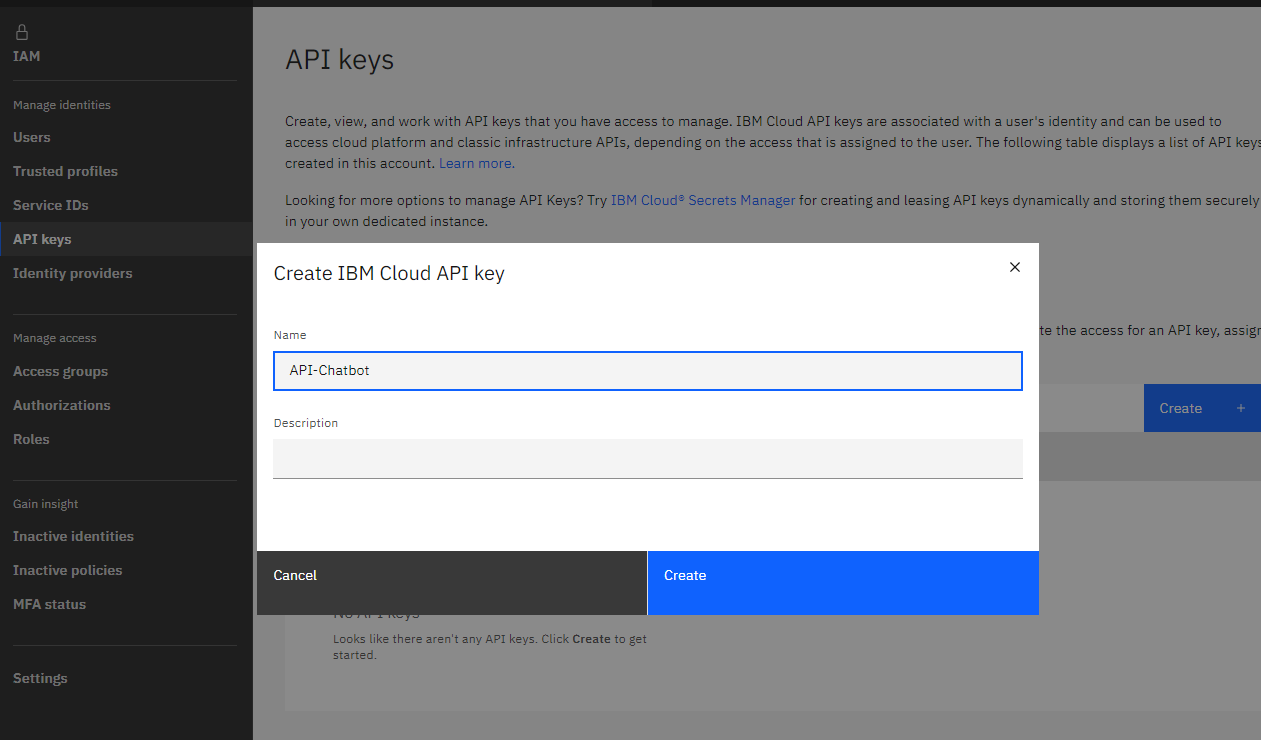
click in create and we copy API key
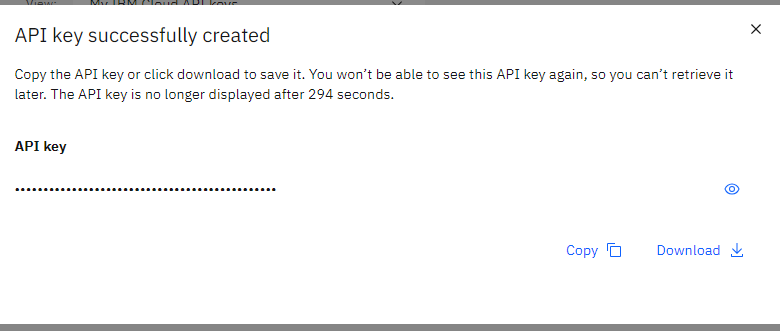
we create a .env file in the project directory with the API_KEY value
for example
echo API_KEY=9NKl890s53sdsdsdw24nFmK-1uddssdfshP6IbvSj > .env
Then we need to add the PROJECT_ID, by clicking your Project here and then Manage and copy the
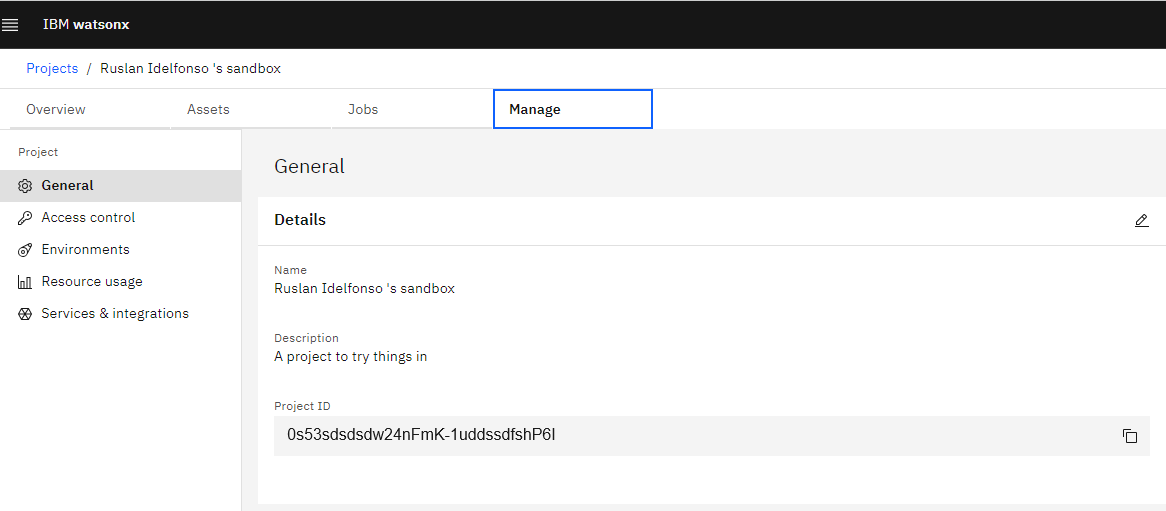
echo PROJECT_ID=0s53sdsdsdw24nFmK-1uddssdfshP6I >>.env
Step 3 . Setup libraries
Once we have our running environment we install our kernel
python -m ipykernel install --user --name WatsonX --display-name "Python (WatsonX)"
pip install langchain ibm-watson-machine-learning
and we install some additional packages,
First, make sure you have TensorFlow and TensorFlow Hub installed:
pip install python-dotenv chromadb openai tiktoken tensorflow tensorflow-hub tensorflow_text
then we can run our notebook as follow:
jupyter notebook
and we create a new notebook

then we select our WatsonX enviroment
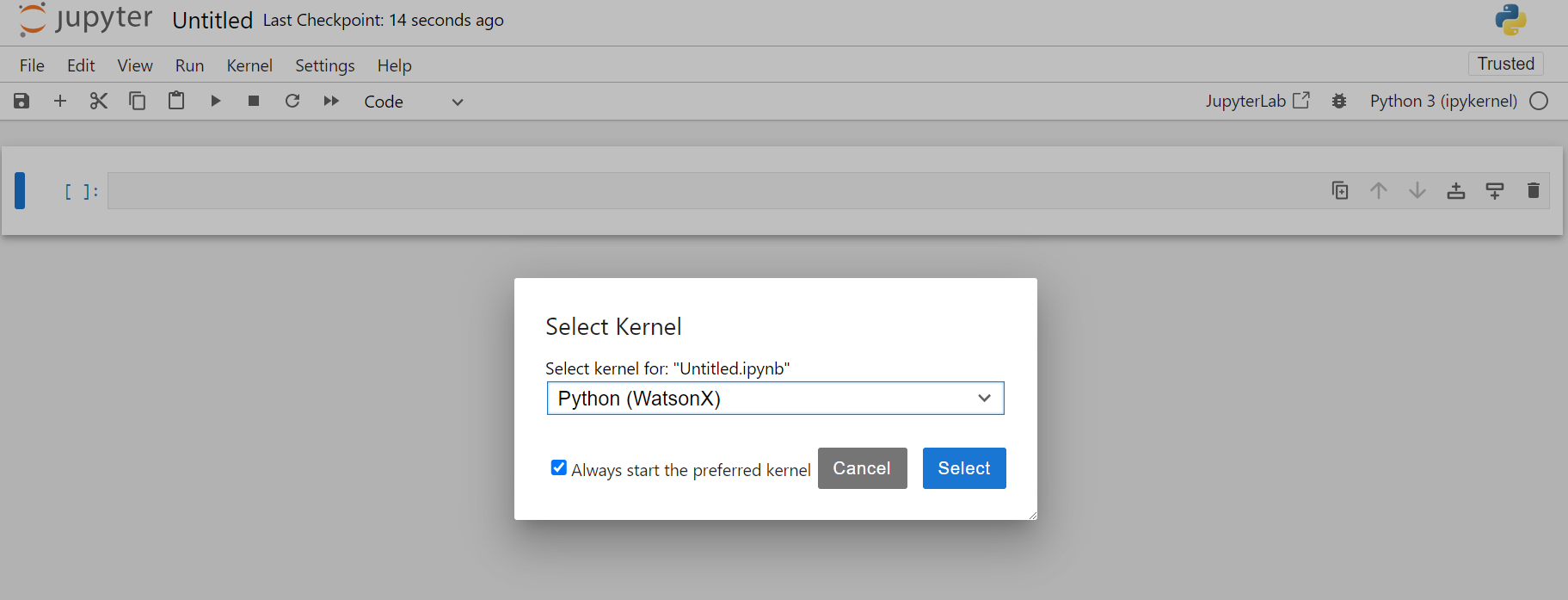
WatsonX with LangChain
We will review how to connect WatsonX with Langchain. We will read a text document and we will ask questions to this document.
First we load our initial libraries.
import os
from dotenv import load_dotenv
from typing import Any, List, Mapping, Optional, Union, Dict
from pydantic import BaseModel, Extra
from langchain import PromptTemplate
from langchain.chains import LLMChain, SimpleSequentialChain
from langchain.llms.base import LLM
from langchain.llms.utils import enforce_stop_tokens
from ibm_watson_machine_learning.foundation_models import Model
from ibm_watson_machine_learning.metanames import GenTextParamsMetaNames as GenParams
load_dotenv()
project_id = os.getenv("PROJECT_ID", None)
credentials = {
"url": "https://us-south.ml.cloud.ibm.com",
"apikey": os.getenv("API_KEY", None)
}
IBM Cloud for WatsonX typically has several regions available for deploying services. Some of the common regions include:
- US South (Dallas) - us-south
- US East (Washington, DC) - us-east
- Europe (Frankfurt) - eu-de
- Europe (London) - eu-gb
- Asia Pacific (Tokyo) - jp-tok
- Asia Pacific (Sydney) - au-syd
To determine the URL for a Watson service in a specific region, you can follow this pattern:https://REGION_ID.ml.cloud.ibm.com
For example, if your region is US South (Dallas), the URL would be:https://us-south.ml.cloud.ibm.com
Foundation Models on watsonx.ai
All avaliable models are presented under ModelTypes class. For more information refer to documentation.
from ibm_watson_machine_learning.foundation_models.utils.enums import ModelTypes
print([model.name for model in ModelTypes])
['FLAN_T5_XXL', 'FLAN_UL2', 'MT0_XXL', 'GPT_NEOX', 'MPT_7B_INSTRUCT2', 'STARCODER', 'LLAMA_2_70B_CHAT', 'GRANITE_13B_INSTRUCT', 'GRANITE_13B_CHAT']
We define our model
model_id = ModelTypes.LLAMA_2_70B_CHAT
Defining the model parameters
You might need to adjust model parameters for different models or tasks, to do so please refer to documentation.
from ibm_watson_machine_learning.metanames import GenTextParamsMetaNames as GenParams
parameters = {
GenParams.DECODING_METHOD: "greedy",
GenParams.MAX_NEW_TOKENS: 200
}
#this cell should never fail, and will produce no output
import requests
def getBearer(apikey):
form = {'apikey': apikey, 'grant_type': "urn:ibm:params:oauth:grant-type:apikey"}
print("About to create bearer")
# print(form)
response = requests.post("https://iam.cloud.ibm.com/oidc/token", data = form)
if response.status_code != 200:
print("Bad response code retrieving token")
raise Exception("Failed to get token, invalid status")
json = response.json()
if not json:
print("Invalid/no JSON retrieving token")
raise Exception("Failed to get token, invalid response")
print("Bearer retrieved")
return json.get("access_token")
credentials["token"] = getBearer(credentials["apikey"])
we got the following result
About to create bearer
Bearer retrieved
we define our llama model in watsonx.ai
from ibm_watson_machine_learning.foundation_models import Model
# Initialize the Watsonx foundation model
llama_model = Model(
model_id=model_id,
params=parameters,
credentials=credentials,
project_id=project_id)
Model’s details
If you wat to get details about the loaded model you can type
llama_model.get_details()['short_description']
'Llama-2-70b-chat is an auto-regressive language model that uses an optimized transformer architecture.'
of simply know the limits
llama_model.get_details()['model_limits']
with this output
{'max_sequence_length': 4096}
Generation AI by using Llama-2-70b-chat model.
It is generated text , according to provided instruction.
instruction = "Using the directions below, answer in a maximum of 2 sentences. "
question = "What is the capital of Italy"
prompt=" ".join([instruction, question])
#dir(model)
Generate_text method
llama_model.generate_text(question)
'?\nThe capital of Italy is Rome (Italian: Roma). Rome is the largest city in Italy and is located in the central-western part of the country. It is known for its rich history, architecture, art, and culture, and is home to many famous landmarks such as the Colosseum, the Pantheon, and the Vatican City.'
Generate method
result=llama_model.generate(prompt)['results'][0]['generated_text']
result
'?\nThe capital of Italy is Rome. Rome is a city located in the central-western part of the country, and it has been the capital of Italy since 1865.'
The strucure of this method has the following structure:
result={'model_id': 'meta-llama/llama-2-70b-chat',
'created_at': '2023-10-24T18:58:01.390Z',
'results': [{'generated_text': '?\nThe capital of Italy is Rome (Italian: Roma). Rome is the largest city in Italy and is located in the central-western part of the country. It is known for its rich history, architecture, art, and culture, and is home to many famous landmarks such as the Colosseum, the Pantheon, and the Vatican City.',
'generated_token_count': 79,
'input_token_count': 7,
'stop_reason': 'eos_token'}],
'system': {'warnings': [{'message': 'This model is a Non-IBM Product governed by a third-party license that may impose use restrictions and other obligations. By using this model you agree to its terms as identified in the following URL. URL: https://dataplatform.cloud.ibm.com/docs/content/wsj/analyze-data/fm-models.html?context=wx',
'id': 'DisclaimerWarning'}]}}
Integration with LangChain
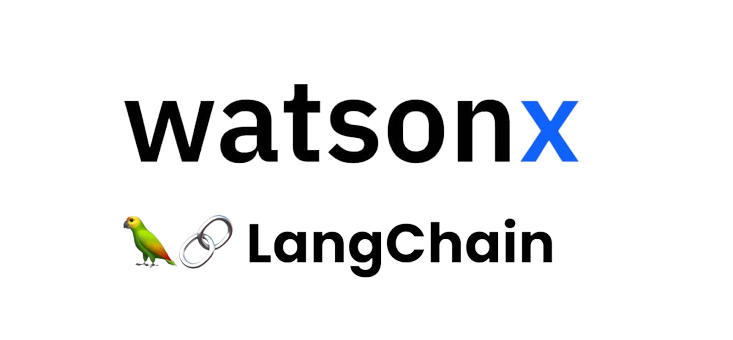
from langchain import PromptTemplate
from langchain.chains import LLMChain
from ibm_watson_machine_learning.foundation_models import Model
from ibm_watson_machine_learning.foundation_models.utils.enums import ModelTypes
First we load our Foundation Model as for example Flan UL2
parameters = {
GenParams.DECODING_METHOD: "greedy",
GenParams.MAX_NEW_TOKENS: 200
}
from ibm_watson_machine_learning.foundation_models import Model
# Initialize the Watsonx foundation model
flan_ul2_model = Model(
model_id=ModelTypes.FLAN_UL2,
credentials=credentials,
project_id=project_id,
params=parameters
)
prompt_template = "What color is the {flower}?"
llm_chain = LLMChain(llm=flan_ul2_model.to_langchain(),
prompt=PromptTemplate.from_template(prompt_template))
llm_chain('sunflower')
{'flower': 'sunflower', 'text': 'yellow'}
Remembering chat history
The ConversationalRetrievalQA chain builds on RetrievalQAChain to provide a chat history component. It first combines the chat history (either explicitly passed in or retrieved from the provided memory) and the question into a standalone question, then looks up relevant documents from the retriever, and finally passes those documents and the question to a question-answering chain to return a response.
To create one, you will need a retriever. In the below example, we will create one from a vector store, which can be created from embeddings.
We are going to read a text document from arxiv

from langchain.embeddings.openai import OpenAIEmbeddings
from langchain.text_splitter import CharacterTextSplitter
from langchain.chains import ConversationalRetrievalChain
#If you want use Chroma or OpenAI uncomment the following lines
#from langchain.vectorstores import Chroma
#from langchain.llms import OpenAI
from langchain.document_loaders import TextLoader
loader = TextLoader("example.txt")
document = loader.load()
When we load the documents with TexLoader the datatype of this object is langchain.schema.document.Document wich is a list of parts of the text.
type(document[0])
langchain.schema.document.Document
Additionally if we want only the contents in string format we just called it by using the method .page_content
Splitting the document
text_splitter = CharacterTextSplitter(separator="\n",
chunk_size=1000,
chunk_overlap=200)
# Split text into chunks
documents = text_splitter.split_documents(document)
Created a chunk of size 1143, which is longer than the specified 1000
The .page_content is an string
type(documents[0].page_content)
str
for example
documents[0].page_content
you got the following result
'Provided proper attribution is provided, Google hereby grants permission to reproduce the tables and figures in this paper solely for use in journalistic or scholarly works.\nAttention Is All You Need\nAshish Vaswani Google Brain [email protected]\n \nNoam Shazeer Google Brain [email protected]\n \nNiki Parmar Google Research [email protected]\nJakob Uszkoreit Google Research [email protected]\n Llion Jones Google Research [email protected]\n \nAidan N. Gomez † University of Toronto [email protected]\nukasz Kaiser\nGoogle Brain\[email protected]\nIllia Polosukhin ‡\[email protected]\nAbstract'
We have created 45 pieces of text, in the next part we are going to create the embeddings of this text.
len(documents)
45
RetrievalQA employs an in-memory vector database, which might not be ideal for every RAG use case. Utilizing an in-memory vector database entails loading data each time, which could prove inefficient for handling extensive documents that consume significant memory resources. As a result, RetrievalQA is better suited for managing smaller documents and prototyping the RAG pattern.
Embeddings
There are different ways to embedding our text, in this demo we want to use Tensorflow embenddings.
from langchain.vectorstores import FAISS
from langchain.embeddings import OpenAIEmbeddings
from langchain.embeddings import TensorflowHubEmbeddings
url = "https://tfhub.dev/google/universal-sentence-encoder-multilingual/3"
embeddings = TensorflowHubEmbeddings(model_url=url)
text_chunks=[content.page_content for content in documents]
vectorstore = FAISS.from_texts(texts=text_chunks, embedding=embeddings)
LangChain’s memory implementation
LangChain’s memory implementation addresses the stateless nature of LLMs by appending both input and output to the prompt. While this approach is easy to comprehend and implement, it’s essential to consider the LLM token limit and token costs for hosted instances. To mitigate these concerns, LangChain offers various memory types like ConversationBufferWindowMemory, ConversationSummaryBufferMemory, and ConversationTokenBufferMemory, which employ different strategies for managing interactions and token limits.
We can now create a memory object, which is necessary to track the inputs/outputs and hold a conversation.
from langchain.memory import ConversationBufferMemory
memory = ConversationBufferMemory(memory_key="chat_history",
return_messages=True)
We now initialize the ConversationalRetrievalChain
#help(ConversationalRetrievalChain.from_llm)
#llm=flan_ul2_model.to_langchain()
llm=llama_model.to_langchain()
qa = ConversationalRetrievalChain.from_llm(llm=llm,
retriever=vectorstore.as_retriever(),
memory=memory)
query = "What is the topic about"
result = qa({"question": query})
result["answer"]
you got the result
' The topic is about the Transformer model in deep learning, specifically discussing its use of self-attention and multi-head attention mechanisms.'
and the memory
memory
you got the result
ConversationBufferMemory(chat_memory=ChatMessageHistory(messages=[HumanMessage(content='What is the topic about'), AIMessage(content=' The topic is about the Transformer model in deep learning, specifically discussing its use of self-attention and multi-head attention mechanisms.')]), return_messages=True, memory_key='chat_history')
Pass in chat history
In the above example, we used a Memory object to track chat history. We can also just pass it in explicitly. In order to do this, we need to initialize a chain without any memory object
#help(ConversationalRetrievalChain.from_llm)
qa = ConversationalRetrievalChain.from_llm(llm=llama_model.to_langchain(),
retriever=vectorstore.as_retriever())
Here’s an example of asking a question with no chat history with Watsonx
chat_history = []
query = "What is the topic about"
result = qa({"question": query, "chat_history": chat_history})
result["answer"]
' The topic is about the Transformer model in natural language processing, specifically discussing the use of self-attention and multi-head attention in the model.'
Here’s an example of asking a question with some chat history
chat_history = [(query, result["answer"])]
query = "What is Transformer"
result = qa({"question": query, "chat_history": chat_history})
result['answer']
we have the output
'\nThe Transformer model is a sequence transduction model that relies entirely on self-attention mechanisms, dispensing with recurrence and convolutions. It is based on attention mechanisms and is used for various tasks such as machine translation, English constituency parsing, and text summarization. The Transformer model is the first transduction model that uses self-attention to compute representations of its input and output without using sequence-aligned RNNs or convolutions. It has been shown to be superior in quality, more parallelizable, and requiring significantly less time to train than other sequence transduction models.'
and the chat history
chat_history
you got the result
[('What is the topic about',
' The topic is about the Transformer model in natural language processing, specifically discussing the use of self-attention and multi-head attention in the model.')]
Congratulations! You have finished this tutorial of WatsonX with LangChain.
For more tutorials like this visit https://ruslanmv.com/
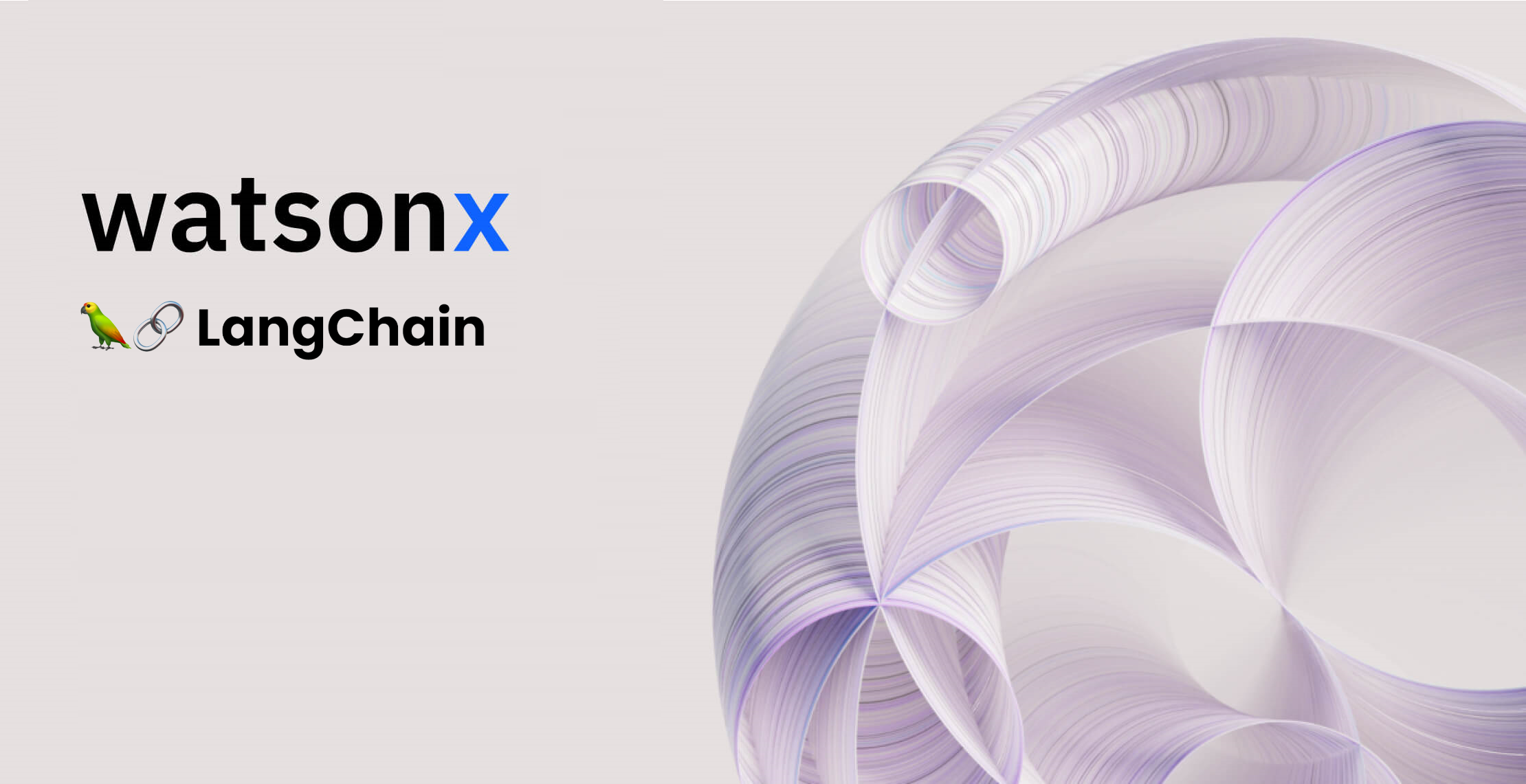
Leave a comment